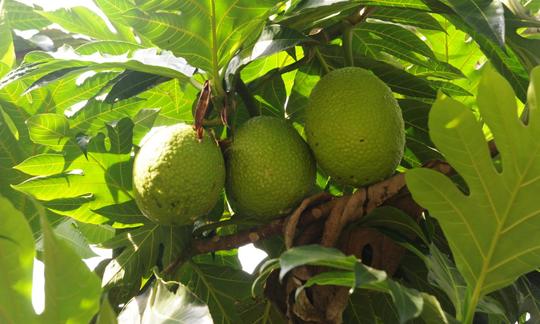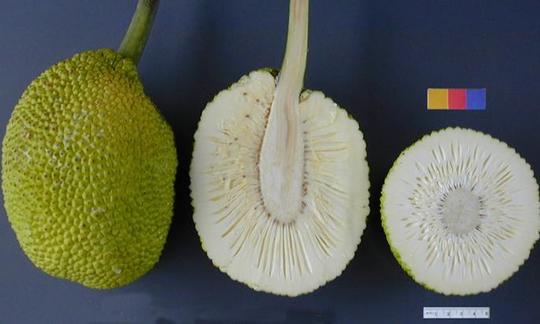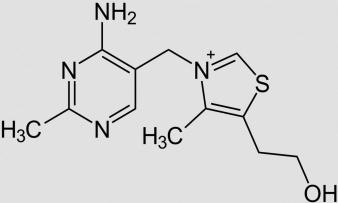The breadfruit is also known as breadfruit or bread tree fruit.
Use in the kitchen:
The flesh of the unripe breadfruit ( Artocarpus altilis) is white to yellowish, juicy and interspersed with fine threads. The taste is mild and neutral. In the countries of origin, the unripe fruit is enjoyed as a vegetable substitute, boiled, roasted or fried.
The nut and fruit mixture has a high starch content, is very filling and can be used in just as many ways as potatoes, e.g. in gratins, curries or salads.
When fully ripe, the flesh is golden yellow. It can then also be eaten raw and tastes fruity and sweet. When ripe, the aroma is reminiscent of mango or pineapple and the consistency is creamy, similar to pudding.
If you puree the flesh of the breadfruit, there are many possible uses. For example, you can make soups, porridge, syrup, jams or desserts from it. Roasted breadfruit has an aroma like freshly baked bread.
The fruits of the breadfruit trees contain chestnut-sized seeds, known as breadnuts. When roasted, these taste like sweet chestnuts. 1,2
In the countries of origin, the dried fruit pulp is used to make flour, which is mixed with grain flour to bake bread. In tropical countries, the breadfruit is an important part of the diet, along with protein-rich foods such as beans or pulses. 3
Purchasing:
The breadfruit is a fruit about the size of a human head with a green, wart-like skin. This is relatively thin and edible when ripe. One fruit can weigh up to 4 kg. The riper the breadfruit, the softer it feels. 1.4
Because of its size and sensitivity to pressure, the breadfruit is not particularly easy to transport. This is why the fresh fruit is not available everywhere. In France, England and the Netherlands, breadfruit is relatively easy to find, but in Germany it is almost impossible to get it fresh. 1,2 However, the fruit parts can be bought in cans or dried in delicatessens, Asian shops or online shops in other European countries. Breadfruit is easier to get in the USA.
Found in the wild:
The wild ancestor of the breadfruit tree ( Artocarpus integer or champeden) looks very similar to the cultivated tree ( Artocarpus altilis, formerly communis). The fruits are somewhat smaller and the leaves have thick, brown hairs. In addition, the flesh of the wild breadfruit has an intrusive, almost repulsive smell and more seeds than the cultivated fruit. 5
Storage:
You can sprinkle lemon or lime juice on a sliced breadfruit to prevent oxidation. Fresh breadfruits only last a few days, even if they are kept in the fridge. In their countries of origin, they are therefore often only available dried. 1
Ingredients:
The breadfruit consists mainly of carbohydrates (27%), some protein (1-2%) and hardly any fat (0.2%). Since you eat the peel, the fiber content of the breadfruit is around 5 g/100g, which is slightly higher than that of the jackfruit (1.5 g/100g). The breadfruit is a good source of vitamin C and potassium. It also contains vitamin B1, vitamin B5 and folate (folic acid). The breadfruit also contains the trace element copper and the mineral magnesium. 9 You can find detailed information in the ingredient tables after the text.
Health aspects:
The breadfruit is one of the main foods for people in the tropics. The starch in the breadfruit is slowly converted into glucose during digestion and is the main source of energy for the body's cells. The fiber it contains keeps the intestines healthy and promotes digestion. Vitamin C strengthens the immune system, vitamin B1 is important for thyroid function and for the nerves. The mineral potassium regulates the water balance in the cells and helps with gastrointestinal diseases.
In the growing areas, the fruit compensates for the lack of grain. It is nutritious and healthy. 3
Dangers / Intolerances:
The milky juice that flows from the breadfruit tree, the fruit stalk and also from the unripe fruit shell can cause skin irritation. 6
The seeds of the breadfruit tree contain toxins that are neutralized by heating.
Occurrence:
The tree originally comes from the South Seas. The Polynesian inhabitants brought it on their sea voyages throughout the Pacific region and as far as Hawaii. Today the tree species is widespread throughout the tropics. The breadfruit is one of the most popular fruits and vegetables in Jamaica. It is part of every meal. 4.7
The tree can grow up to 20 m tall. It has a large, shade-giving crown with leaves up to one meter long. These are very shiny and lobed. The trees are not only useful for food production, they also strengthen the soil and protect it from erosion. 1 A breadfruit tree can reach a trunk diameter of up to one meter. The plants often have so-called buttress roots, which give the tall trees in the tropical rainforest better stability. In monsoon countries or in regions with dry seasons, the tree sheds its leaves. 5,6
Cultivation, harvest:
Breadfruit trees ( Artocarpus altilis) bear flowers and fruit all year round. There are often many small, yellowish to brownish flowers. The tree is monoecious, meaning that each tree has male and female flowers that are visually different from each other. After pollination, the female flowers develop into spherical aggregate fruits (syncarpy). A breadfruit tree produces fruit up to three times a year. 6 Among the cultivated local varieties of breadfruit, there are now also seedless fruits. 5
Because of the skin-irritating milky sap, the green fruits in the tall trees are often harvested by breaking them off with a stick. 1.6
Danger of confusion:
The breadfruit could be confused with a small jackfruit. But not only the size, but also the shells are different. The jackfruit has a dimpled shell.
It is also possible to confuse it with the durian fruit ( Durio zibethinus) from the mallow family (Malvaceae). However, if you cut open the shell, this fruit smells very strong. This is why the durian is also called stink fruit or vomit fruit. 7
The breadfruit could also be confused with the baobab fruit. This 25-40 cm long, edible fruit hangs on long stems from the crown of the African baobab tree ( Adansonia digitata). The tree also belongs to the mallow family (Malvaceae) and is one of the best known and most characteristic trees in Africa.
General information:
Breadfruit trees ( Artocarpus) belong to the mulberry family (Moraceae). The names Artocarpus altilis (Parkins), Artocarpus communis (Forst) or Artocarpus incisus (Thunb.) are used as synonyms.
There are many useful species of breadfruit trees. Several dozen species are found on the Southeast Asian islands. The natives use the good wood, the milky sap and, above all, the aggregate fruits. Two species are of particular importance for tropical crop research: the Polynesian true breadfruit tree ( Artocarpus communis Forst.) and the Indian jackfruit tree ( Artocarpus heterophyllus Lam). 5 Other well-known breadfruit tree species are Cempedak ( Artocarpus chempedak) and Marang ( Artocarpus odoratissima).
The bast of the breadfruit tree, which lies beneath the bark, is used by the local people as a weaving and binding material. They use it to weave shoes, handbags, fabrics or household items. 5
The name breadfruit tree probably comes from the first Europeans who discovered the fruit in Tahiti as a baked good. The 'Polynesian biscuits' tasted like wheat bread. The breadfruit trees require practically no care and thrive everywhere on Tahiti. This gave the Europeans the idea of exporting these plants to the English colonies, where the breadfruit would serve as food for the slaves.
The legendary mutiny on the Bounty was caused by 1,000 breadfruit trees. In 1792, the British ship Bounty, under Captain Bligh, transported the seedlings from Tahiti to the English colonies in the Caribbean. In order to save the precious trees, the captain ordered the crew to ration their drinking water. This led to a mutiny. The crew members abandoned their captain on the open sea, threw all the trees overboard and traveled back to Tahiti. The attempt to export the breadfruit failed and Captain Bligh's journey ended on a lonely island in the South Pacific. But after his rescue, Captain Bligh undertook another breadfruit tree expedition. Countless seedlings arrived in the West Indies on the ship Providence, where they were immediately cultivated. Despite malnutrition, the slave population refused to accept the breadfruit as food. 5 After eating the fruit, the slaves suffered from strong winds that smelt for a long time and far away. This was to the delight of the farm owners and overseers, who were thus able to find the fugitives again and again. With the cultural and social change, the status of the fruit also changed from 'food of paradise' to poor man's food. 8 ,5
Literature - Sources:
Bibliography - 8 Sources (Link to the evidence)
| 1. | Biothemen.de Brotfrucht. |
| 2. | Gemüsekorb.info Brotfrucht. |
| 3. | Pamplona-Roger J. Heilkräfte der Nahrung. Advent-Verlag: Zürich 2006. |
| 5. | Brücher H. Tropische Nutzpflanzen. Ursprung, Evolution und Domestikation.Springer Verlag: Berlin. 1977:351-353. |
| 6. | Wikipedia Brotfruchtbaum. |
| 7. | Springlane.de Jackfrucht Unterschied Durian. |
| 8. | DeLoughrey EM. Globalizing the Routes of Breadfruit and Other Bounties.Journal of Colonialism and Colonial History 8:3. Johns Hopkins University Press. Winter 2007. |
| 9. | USDA United States Department of Agriculture. |










Comments